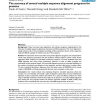Free Online Productivity Tools
i2Speak
i2Symbol
i2OCR
iTex2Img
iWeb2Print
iWeb2Shot
i2Type
iPdf2Split
iPdf2Merge
i2Bopomofo
i2Arabic
i2Style
i2Image
i2PDF
iLatex2Rtf
Sci2ools
BMCBI
2006
2006
The accuracy of several multiple sequence alignment programs for proteins
Background: There have been many algorithms and software programs implemented for the inference of multiple sequence alignments of protein and DNA sequences. The "true" alignment is usually unknown due to the incomplete knowledge of the evolutionary history of the sequences, making it difficult to gauge the relative accuracy of the programs. Results: We tested nine of the most often used protein alignment programs and compared their results using sequences generated with the simulation software Simprot which creates known alignments under realistic and controlled evolutionary scenarios. We have simulated more than 30000 alignment sets using various evolutionary histories in order to define strengths and weaknesses of each program tested. We found that alignment accuracy is extremely dependent on the number of insertions and deletions in the sequences, and that indel size has a weaker effect. We also considered benchmark alignments from the latest version of BAliBASE and the ...
| Added | 10 Dec 2010 |
| Updated | 10 Dec 2010 |
| Type | Journal |
| Year | 2006 |
| Where | BMCBI |
| Authors | Paulo A. S. Nuin, Zhouzhi Wang, Elisabeth R. M. Tillier |
Comments (0)

